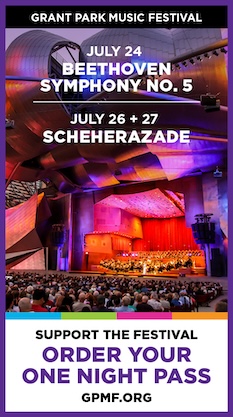Third Coast Baroque returns with an intimate program of love songs

Third Coast Baroque presented its first in-person concerts since fall of 2019 this weekend with rarely heard gems by Monteverdi and his contemporaries. The program was based on the poetry of “Song of Songs,” also known as “Song of Solomon,” a collection of love poems found in the Hebrew Bible.
Sunday afternoon’s concert was held in the atmospheric Ganz Hall at Roosevelt University, where the lights were dimmed and the stage and aisles were decorated with a host of white pillar candles (battery-powered, of course).
As soprano Nathalie Colas explained in her introduction, the poems are unique in that they alternate between the male and female perspective and describe the physical attributes of both the man and the woman. These sensual yet sacred texts were favorites of 17th-century composers such as Monteverdi, who delighted in “depicting passionate love through luscious and delicate melodies.”
The well-paced program featured a mixture of vocal duets, solos, and instrumental pieces inspired by these texts. A paired down continuo ensemble of violist da gamba Anna Steinhoff, theorbist Brandon Acker and organist Sun Chang supported sopranos Colas and Kaitlin Foley.
In a nice touch, the singers recited the English translations of the poetry before each vocal piece, allowing the audience to ignore the program booklets in their laps and lose themselves in the music-making on stage. Even without the recitations, the passion and emotions were easily understood due to the text painting of the music and the singers’ expressive musical interpretations.
The two sopranos shone brightest when paired together in the five vocal duets on this program. Though possessing distinct vocal timbres, their voices complemented each other’s splendidly—Colas’s creamier, more covered tone providing a grounding counterbalance to Foley’s sparklingly innocent soprano.
The pleasant contrast between their voices was further highlighted in a duet by Giovanni Paolo Cima, “Surge propera,” in which Colas and Acker echoed the instrumental trio’s music from offstage. The effect, which came as a surprise, was magical, and given the atmospheric lighting, one could easily imagine being in an ancient Cathedral, hearing the voices echo off the limestone. Especially impressive was when the two groups cadenced together in perfect ensemble, despite Colas and Acker being behind a door with no sightline to the other musicians.
Foley and Colas each offered a solo piece as well. Colas sang “O dulcissima dilecta mea” by Stefano Bernardi, displaying a firm command of the poetry and style. The piece featured exuberant sprezzatura to text-paint words such as “surge” (“rise”) and a spritely “Alleluia” section, which Colas executed expertly. Her intonation on the straight-tone chromatic shifts could have been more precise, however, which would have heightened the sensuous impact of these moments.
Foley delighted with the emotional “O quam tu pulchra es” by Alessandro Grandi. Foley’s voice, gleaming, flexible, and remarkably present in the lower and middle registers, is made for this music and she could have given Emma Kirkby a run for her money in the latter’s heyday. Foley demonstrated great control, particularly in her use of subtle messa di voce on the “O” of each repetition of the cascading line “O quam tu pulchra es.”
Between the vocal selections, each of the instrumentalists had a moment to shine.
A Fantasia by Bartolomé de Selma y Salverde showcased Steinhoff’s virtuosic and earthy viola da gamba playing, sensitively accompanied by Chang and Acker. This transitioned into Canario by Giovanni Girolamo Kapsberger, with Steinhoff providing the hypnotic ground bass line and Acker delivering a quasi-improvised embellished melody that had echoes of Monteverdi’s “Pur ti miro”—one of the most famous love duets of the era.
Later, Chang offered an intimate rendition of Girolamo Frescobaldi’s “Ave Maris Stella,” which highlighted the more sacred nature of these passionate texts, and Acker treated us to another solo with Kapsberger’s Toccata Arpeggiata.
The stream of Saturday night’s performance at Luther Memorial Church is available from Tuesday through November 30. thirdcoastbaroque.org
Posted in Uncategorized
